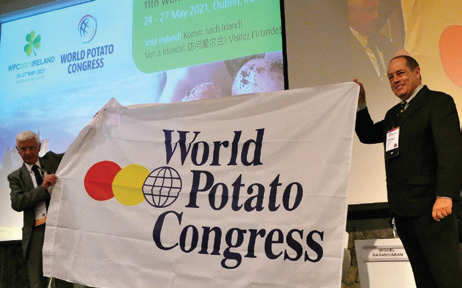Lorcan Bourke, business analyst at Bord Bia reports on the 10th World Potato Congress, Peru May 2018 |

The 10th World Potato Congress was held in Cusco, Peru on 27 to 31 May 2018 with congress themes exploring biodiversity, food security and business. This congress is held every three years in a different host country across the planet.
Depending on the local hosting country, the themes of the event are usually set by the local country or region. Previous host countries in the past decade have been China, Scotland and New Zealand. Maybe some readers are wondering why you would even have such a congress for one crop. Well, the answer lies in the fact that after wheat and rice, potatoes are the third most important crop providing food to humanity, and as such they are grown in almost every country on the planet. While more maize area is actually grown, the maize crop is not uniquely used to feed humans, with sizeable areas grown from both animal feed and bioethanol. Of course, the other huge human interest in potatoes is their sustainability credential. It takes 100 times less water to grow them than rice, which has been particularly noted in Asia and parts of the planet being pressurised to sustain ever-growing human populations. So here’s the large irony of this highly nutritious crop: it seems that the wealthier more developed your society becomes the more likely you will substitute potatoes with alternative carbohydrates and/or you will switch from the healthier cooking formats of fresh potatoes to consuming them as crisps or chips. Any statistics I’ve reviewed on the matter in the past decade show increased growing of potatoes in less developed countries to provide food, with a gradual decline in fresh potato consumption occurring in developed western economies.
But back to Cusco and the Irish interest. From 24 to 27 May 2021, Ireland will host the 11th World Potato Congress in Dublin. The Irish Potato Federation (representing Irish potato packers and merchants) succeeded in promoting Ireland as a suitable venue for this event in 2021, beating off contenders from the southern hemisphere and our Dutch neighbours. The Irish Potato Federation will be supported in the organisation of this event by Bord Bia and Teagasc horticultural teams and hence our presence at Cusco, to see how the Peruvians do it. With this mission, two representatives from the IPF, three from Teagasc (Oak Park Potato Breeding programme), and I representing Bord Bia attended the congress.
CUSCO AND PERU
Many people asked me since my return, “What was it like out there?” and my consistent answer has been that as a country, Peru was like walking onto another planet in terms of everything being just so different. If one of the themes of the congress was biodiversity, we struck a rich vein of practical experience. It was my first experience of travelling in a developing country and I realised that the first thing that hits you is your own observation of human experience within the country. Cusco is the largest city in the Peruvian Andes, perched 3,500m above sea level. My hotel promotional literature boasted proudly of access to oxygen tanks and masks in reception, and they were there. Cusco for me seemed to be a ‘one stop shop’ of Peruvian Andean culture. The town itself was a model of Spanish architecture, with two major cathedrals dominating the town centre, at either side of six segments of a fabulously well-kept park with a fountain and a statue of an Inca warrior at its centre.
“Of course the other huge human interest in potatoes is their sustainability credential. It takes 100 times less water to grow them than rice” |
If a culture is to be judged by its gardening and ornamental space, this is a very rich culture indeed. My town walks in the following days would reveal this to be true as I found another town park or green open space was always around the corner. Markets and selling seemed to take place around these parks, but I was struck by how many times I saw groups of young teenagers under dance instruction. Dance and ritual seemed to be a constant pursuit of the locals. The parks were alive with people at all times with communities actively using them for various activities. One smaller park I saw which struck me was one that seemed dedicated to educating the townspeople on the names of the trees, shrubs and flowers of the region.


THE CONGRESSThe congress opened on Sunday and went right through until the following Thursday. The immediate thing to strike me was the onus on the host country to create interesting potato related content to engage delegates for five days. The delegates were from all over the world and included the top potato research scientists, knowledge transfer people, traders and merchants. The whole reason for the congress being held in the Andes was that potatoes as a plant species had originated in this region. In my experience and reading of the situation, potatoes seem to fit one of two roles internationally. In many less developed countries, they are grown as a highly valued nutritious carbohydrate to provide staple energy to the population. In more developed western societies fresh potatoes are reached for as a comfort food, an old friend but carrying a much more traditional cuisine association. In this role, they are often much loved but are forced to battle it out with the invasion of competitive foods available in the modern-day marketplace. In Peru, they took on the former role, providing sustenance to a large part of the population in their everyday lives. My lasting memory of this conference will be many papers and research projects exploring the rich genetic heritage of potatoes in the Andes. With over 4,000 recorded varieties and types, of every shape and colour, Peru has to be the genetic home of the potato. CIP, the international potato research body based in Lima, undertakes much varietal research to support the cultivation of potatoes worldwide, releasing potato varieties of high genetic potential to the world. Over all days of the congress the three themes were visited time and again from many different angles. A clear picture emerged of a crop of huge potential to solve many of the planet’s increasing population problems and sustainability goals. The rapid adoption of the potato in China, in particular, is manifest in the crops’ merits to maximise food production with the least use of environmental resources. Scientific papers were presented and information exchanged over the few days between many of the brightest minds on the planet, which is at the very core of the WPC. My main interest was in the papers discussing how to ‘position’ potatoes in the minds of modern consumers and how to bring them to life in an exciting (and delicious) ‘foodie’ way. A scientific field trip to a potato research station on the last day brought me into the heart of Inca culture. The research station was perched high up on Inca terraces going up the side of a long wide expansive mountain valley. Ice-capped mountains reached up out of the surrounding valleys. The stone walls of these huge terraces seemed to provide a very real link between the past and the future of the potato in these lands. About half the delegates were brought on a tour of this research station, while the other half visited Potato Park, which celebrates Peru’s cultural links with potatoes. The research station provided a fascinating whistle-stop tour of 20 individual science-based projects, where everything from frost tolerance to nutrient augmentation were being bred into new varieties. Over the course of the five days, I met potato people from all over the world people who had dedicated their lives to solving world hunger, people who sought world domination of the processed crisps and chips markets. I met the top research scientists, potato growers, chefs and marketing people from every nation. My conclusion: we probably have the best food crop in the world available to us. It’s my job, and the job of every potato industry engaged person, to tell the people of Ireland, just what they actually have and never let them take potatoes for granted. ✽ |
  |









